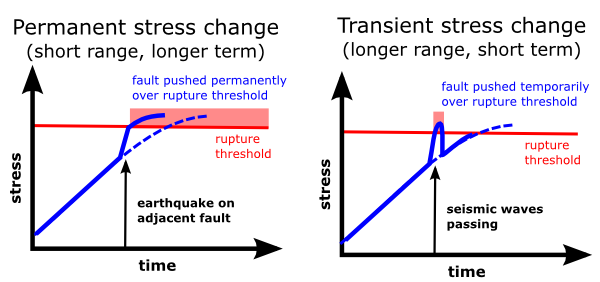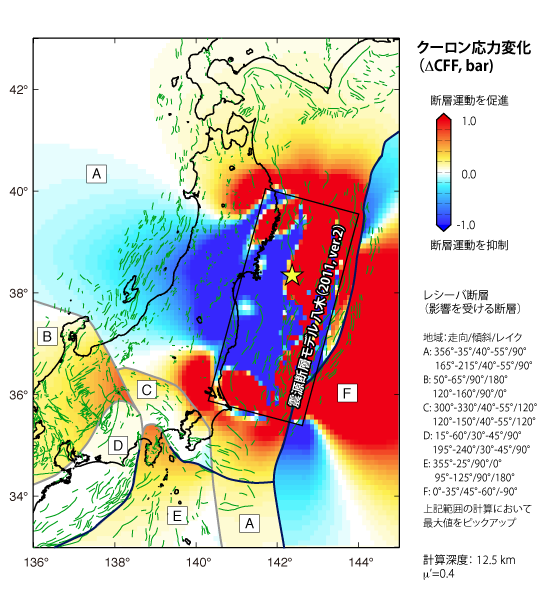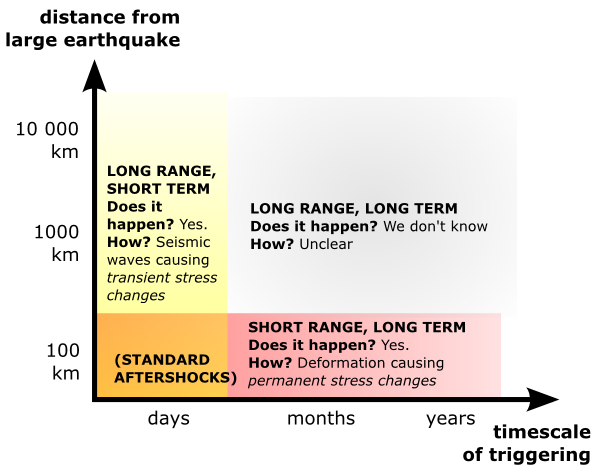![]()
![]() Can large earthquakes beget more large earthquakes? It’s an easy question to ask, but much more difficult to answer. Depending on the distance from, and time since, the initial earthquake, the processes that may result in ‘seismic triggering’ are very different – and the evidence of there actually being any effect to explain at all varies from fairly solid to rather tenuous.
Can large earthquakes beget more large earthquakes? It’s an easy question to ask, but much more difficult to answer. Depending on the distance from, and time since, the initial earthquake, the processes that may result in ‘seismic triggering’ are very different – and the evidence of there actually being any effect to explain at all varies from fairly solid to rather tenuous.
The basic concept of seismic triggering is that if a particular fault is already stressed close to the point of failure, seismic energy produced by an earthquake elsewhere may, by slightly increasing the stress across the fault still further, provide the extra nudge necessary to cause a rupture. The triggering event doesn’t so much cause the earthquake as change its timing; the resultant earthquake would have happened eventually anyway, because the overall cycle of stress build-up and release on any fault is ultimately driven by regional tectonic forces that continue to operate in the background regardless.
There are two ways that a large earthquake can change the state of stress on surrounding faults: deformation of the crust around the rupture produces permanent stress changes, and seismic waves radiating away from the rupture point (which, like more standard sound waves, jostle around the material they are travelling through) produced short-lived transient or dynamic stress changes. The figure below shows how permanent and temporary stress increases on a fault, due to seismic activity elsewhere, can push it over the threshold where it will be likely to rupture. It also illustrates one of the key differences between these two modes of triggering: permanent stress changes due to deformation can not only push a fault over its rupture threshold, but keep it there, months or even years later, until the fault finally fails in an earthquake. In contrast, the stress changes due to the passage of seismic waves can only temporarily push a fault over the threshold, before the stress settles back down to its initial level. The time window in which an earthquake can be triggered by seismic waves is therefore much shorter: probably days at most.

A comparison of seismic triggering due to permanent and transient stress changes. The stress across a fault gradually increases over time due to regional tectonic forces, but additional stresses from an earthquake elsewhere can push the fault over its rupture threshold earlier than expected.
These mechanisms also differ in the range over which they operate. Unlike seismic waves, which can propagate all the way around to the other side of the globe, permanent stress changes are restricted to a fairly localised area of crust around a fault rupture; deformation dissipates the forces generated by the fault’s movement before they can be transmitted large distances*. Even in the case of the very large earthquakes like March’s magnitude 9.0 Tohuku earthquake, significant static stress changes only occurred out to a couple of hundred kilometres from the rupture.

Permanent stress changes in the crust in Japan due to the March 11 Tohuku earthquake. Source: Shinji Toda, Kyoto University
Despite these differences in range and timescale, there is ample evidence that both of these mechanisms cause large earthquakes to trigger other quakes. Calculations of permanent stress changes in the wake of the magnitude 9.1 subduction megathrust earthquake that occurred off the coast of Indonesia in December 2004 indicated increases in stress on the subduction zone to the south-east: this segment then ruptured in a magnitude 8.7 earthquake in March 2005, less than a month after the stress calculations were published. A global spike in background seismic activity also tracked the passage of seismic waves from the 2004 Sumatran earthquake around the world, and the Tokohu earthquake appears to have produced the same effect. Events dynamically triggered by seismic waves from distant earthquakes tend to be small, detectable only by seismometers. A recently published study indicates that dynamically triggered earthquakes of greater than magnitude 5 – the potentially damaging ones – only occur within 1000 km** (and 20-30 hours) of the initial rupture.

Increase in seismic activity following passage of surface waves produced by the M 9.1 2004 Sumatran earthquake. Source: Velasco et al. 2008, Fig 2.
So, earthquakes can trigger other earthquakes by inducing permanent stress changes on nearby faults: the effects are local, but the resulting triggered earthquakes can be large, and there is a long term increase in the seismic hazard on the faults affected. Earthquakes can also trigger other earthquakes due to temporary stress changes from passing seismic waves: these effects can work at great distances from the initial rupture, but are short-lived and do not appear to trigger large earthquakes at such distances. But the outstanding question is whether there is potentially a third domain of seismic triggering: a mechanism that acts at long ranges, but can trigger earthquakes sooner than they would occur otherwise, but months or years after the initial triggering event.

The three domains of seismic triggering. Two are proven, and understood. The third is neither, even though it probably excites the most speculation.
(Note: as Eric Fielding points out in the comments below, I neglected to mention – and show in the now amended original figure – that standard aftershocks plot in the bottom left.)
If this sounds a little bit familiar, this is exactly the sort of effect that Simon Winchester was rather recklessly speculating about a few weeks back. Unfortunately, our records of seismic activity are not long enough to tell if such a mechanism does exist, and our understanding of how faults rupture does not provide many clues as to why faults would react in such a way to a transient stress change. This doesn’t mean that they don’t, and the possibility that large earthquakes can trigger further seismic disasters at a distance clearly needs to be rigorously investigated, even if it’s only to definitively rule it out. In the meantime, however, if you’re hearing talk about seismic triggering, make sure you’re clear on which of the very different kinds of triggering is being discussed.
*Tectonic plates are often described as rigid, because they mostly move as if they are – most of the action takes place at their edges. But they’re not truly, totally rigid in the mechanical sense, as is attested by the presence of faults and earthquakes in plate interiors, and even the distribution of aftershocks following a large earthquake at a plate boundary. If you want to get technical, its probably more accurate to say that a plate is in a state of dynamic equilibrium – the driving forces on the edges and base of the plate all combine to produce coherent motion.
**Interestingly, this is the same sort of distance over which seismic waves from large earthquakes are able to trigger volcanic eruptions.
References
McCloskey, J., Nalbant, S., & Steacy, S. (2005). Indonesian earthquake: Earthquake risk from co-seismic stress Nature, 434 (7031), 291-291 DOI: 10.1038/434291a
Velasco, A., Hernandez, S., Parsons, T., & Pankow, K. (2008). Global ubiquity of dynamic earthquake triggering Nature Geoscience, 1 (6), 375-379 DOI: 10.1038/ngeo204
Parsons, T., & Velasco, A. (2011). Absence of remotely triggered large earthquakes beyond the mainshock region Nature Geoscience DOI: 10.1038/ngeo1110



Comments (4)
Links (2)
-
-
Pingback: ResearchBlogging.org News » Blog Archive » Editor’s Selections: Cyborg rats, Cicadas and birds, Triggered Earthquakes and Trapping Anti-matter
Pingback: RB Editor’s Selections: Cyborg rats, Cicadas and birds, Triggered Earthquakes and Trapping Anti-matter